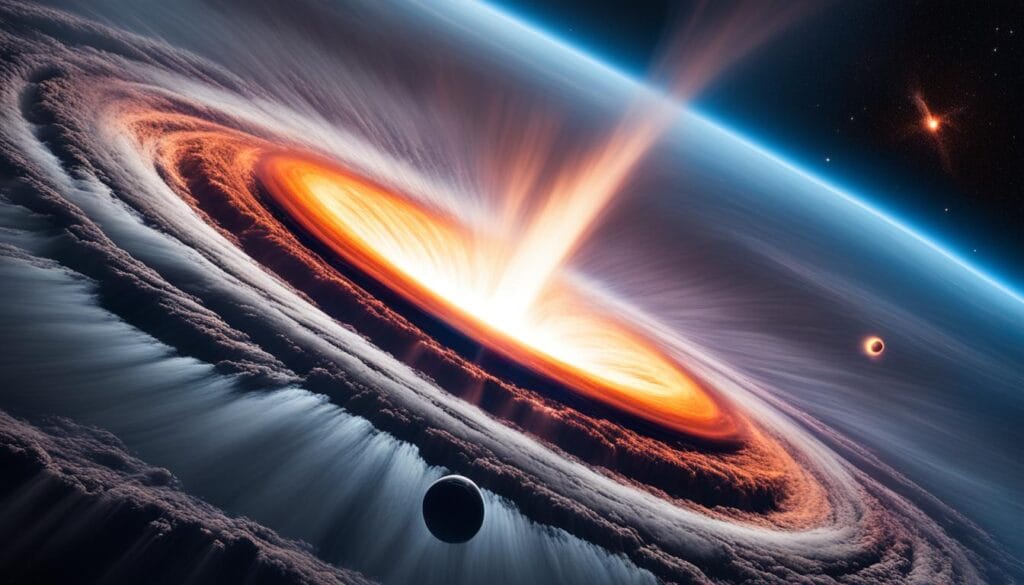Black holes are the most mysterious and fascinating objects in space. They pull everything towards them with an incredible force. This force is so strong, not even light can escape once it gets too close.
These objects are like cosmic vacuum cleaners. They have such a strong gravity that warps space and time around them. This makes black holes hard to understand.
Black holes come in different sizes, from small ones made from stars to huge ones in the center of galaxies. They are the strongest gravity wells in the universe. They pull in everything that gets too close, including stars, planets, and even space itself.
Studying black holes has taught us a lot about the universe. It helps us understand how galaxies formed and how gravity works. By exploring black holes, we learn about the universe’s origins and the strange laws that govern it.
The Discovery of a Record-Breaking Black Hole
Astronomers have found a massive black hole that breaks all previous records. It’s located 13 billion light-years away and dates back to just 400 million years after the Big Bang. This makes it one of the earliest known black holes in the universe.
This black hole is at the center of the galaxy GN-z11. It’s an astonishing 1.6 million times more massive than our Sun. The early black holes found before were only about 10 to 100 million times the mass of the Sun. This new black hole’s size is a surprise, showing it grew much faster than expected.
The power of gravitational lensing helped make this discovery possible. This effect makes the light from distant galaxies look brighter. The X-rays from the black hole were made clearer by this effect, thanks to the James Webb Space Telescope and the Chandra X-ray Observatory.
This record-breaking black hole is not just big; it also tells us a lot about the early universe. It shows how massive black holes can form early on, just 3% of the universe’s current age.
This discovery highlights the power of modern astronomy. It shows how we can learn about the early universe and the role of black holes in galaxy formation. As we keep exploring, we’ll likely find more amazing things that help us understand the universe better.
Black Holes: Stellar Crushing Machines
The Birth of a Black Hole
Black holes start when massive stars collapse at the end of their life. This happens when the star’s pressure can’t fight its gravity anymore. The star then implodes, creating a point of incredible density – a singularity.
Stellar black holes have masses from about 5 to several tens of solar masses. The largest one found weighs 15.65±1.45 times that of our Sun.
The Event Horizon: The Point of No Return
The singularity is covered by the event horizon. This is the point of no return, where even light can’t escape the black hole’s gravity. Once past the event horizon, objects are pulled in and crushed by gravity, where physics as we know it ends.
The event horizon is the boundary that shows where a black hole is. It’s where spacetime curves so much that nothing, not even light, can get out.
Creating black holes is a complex event. It usually happens when a star with at least 2 to 3 times our Sun’s mass collapses. This can lead to a stellar-mass black hole, with masses between 3 to 15 solar masses.
But black holes can also form from white dwarfs or neutron stars. This happens when they gather material from a binary partner.
Black holes are not just interesting objects but also key to understanding the universe. By studying them, scientists learn about spacetime, galaxy evolution, and the laws of physics that rule our universe.
Black Holes
Black holes are mysterious and extreme objects in space. They have such strong gravity that nothing, not even light, can escape. At their center is a singularity, where gravity is so strong it breaks the laws of physics.
The event horizon is the point of no return around a black hole. It’s a challenge to our understanding of science. Black holes vary in size, from small ones to huge ones at galaxy centers. Each shows the incredible power of gravity.
| Black Hole Type | Mass Range | Examples |
|---|---|---|
| Stellar-mass | 3-100 solar masses | Cygnus X-1, GW150914 |
| Intermediate-mass | 100-10,000 solar masses | NGC 5252, M82 X-1 |
| Supermassive | 100,000-billions of solar masses | Sagittarius A*, M87 |
Stellar-mass black holes form from massive stars collapsing. Supermassive ones live at galaxy centers, including ours. The existence of intermediate-mass black holes is still debated.
Black holes fascinate and challenge us about the universe. Their gravity, exotic physics, and cosmic impact make them a key area in astrophysics.
The Enigma of Supermassive Black Holes
At the heart of most galaxies, supermassive black holes hide. They are much bigger than the Sun, often by millions or billions of times. These giants pull on stars and gas, shaping their surroundings. Yet, how they form and grow is still a puzzle.
Unveiling the Formation Theories
Scientists have two main ideas about where supermassive black holes come from. One idea is they form from the quick merging of stellar-mass black holes. The other suggests they collapse straight from huge gas clouds. By looking at a newly found huge black hole, we might learn more about these theories. This could help us understand how black holes and their galaxies grow together.
- Supermassive black holes sit at the center of most galaxies, often being much, much bigger than the Sun.
- There are two main theories on how they form: either through the fast merging of stellar-mass black holes or directly from big gas clouds.
- Looking at a newly found huge black hole could help us understand these theories and how black holes and their galaxies change over time.

The mystery of how supermassive black holes form and grow is key in astrophysics. By solving this mystery, we can learn more about galaxy formation and the Universe’s evolution.
Entanglement: The Spooky Connection
The universe is full of mysteries, but one stands out – quantum entanglement. This phenomenon is hard to grasp because it shows how two particles can be connected across vast distances. Scientists and fans of science find it fascinating.
Quantum Weirdness on a Cosmic Scale
In 1935, Einstein, Podolsky, and Rosen first talked about quantum entanglement. In 2022, Alain Aspect, John F. Clauser, and Anton Zeilinger won the Nobel Prize for proving it exists. Their work showed that quantum entanglement is real and changes how we see spacetime and black holes.
Researchers are looking into how black holes affect spacetime. Some think quantum entanglement might be linked to these cosmic giants. The AMPS paper in 2012 raised questions, and the ER = EPR idea in 2013 offered a solution. It linked entangled particles across black holes through wormholes.
Quantum entanglement could change how we use computers, keep information safe, and understand the universe. As we learn more, the link between quantum entanglement, spacetime, and black holes will keep drawing us in.
Space: The Final Frontier
Exploring space has always been a big part of human life. From old times to now, we’ve been drawn to the stars. Our curiosity and love for the cosmos have grown thanks to science fiction stories and tech.
Now, we’re making science fiction a reality with space exploration. This journey takes us to new discoveries and helps us understand the universe better.
The story of space exploration keeps inspiring us. It shows us the power of discovery. We’re now studying black holes, like the ones close and far, to learn more about space.
A Legacy of Exploration and Curiosity
Black holes, from huge to tiny, amaze scientists and the public. They range from a massive 66 billion times the Sun’s mass to a small one, just 3.8 times bigger than our Sun. These discoveries push us to explore more.
Our curiosity has led to amazing finds, like the huge exoplanet Kepler-7b and the VIPER rover on the Moon. These missions help us learn about space and its secrets.
The history of space exploration shows how working together can achieve great things. The Hubble Frontier Fields program is a great example. It’s a team effort between the ESA and NASA to study galaxy clusters and the early universe.

As we keep exploring, our curiosity and wonder will keep driving us. They inspire new people to go out there and solve the mysteries of the cosmos.
The Warped Reality of Black Holes
Black holes show us the extreme side of Einstein’s General Theory of Relativity. This theory says that mass warps the fabric of spacetime. Black holes, with their huge gravity, take this idea to the extreme. They create a place where even light can’t get out.
Einstein’s Revelation: Spacetime Curvature
Einstein realized that gravity isn’t a force. It’s the result of spacetime curvature caused by mass. This idea has changed how we see the universe, especially black holes. These mysterious objects show us the extreme effects of spacetime warping.
Scientists have found that gravity near a black hole bends light in ways we’ve never seen before. This bending lets us see a bright ring around the black hole. This ring is made of many thin rings that fade away, showing the huge spacetime curvature.
As we learn more about general relativity, we understand black holes better. New telescopes might let us see strange images of objects near black holes. This could give us new insights into these cosmic mysteries and our universe.
Conclusion
Black holes are the ultimate cosmic mystery, challenging our understanding of the universe. They push the limits of what we know. From the biggest black hole that helps us understand early galaxies to supermassive ones ruling their galaxies, they fascinate and puzzle us.
Exploring black holes takes us into a strange reality. It connects their behavior to the strange nature of the universe. This opens new paths for discovery that could change how we see space, time, and the universe.
The drive to explore comes from our curiosity and love for the unknown. With tools like LIGO and the Event Horizon Telescope, we’re learning more about black holes. This could lead to big discoveries about our universe.
Studying black holes is key to understanding the universe better. They range from small to supermassive sizes. These mysterious objects could reveal the universe’s deepest secrets, helping us grasp the cosmos more deeply.
